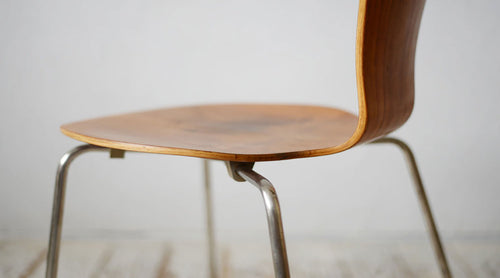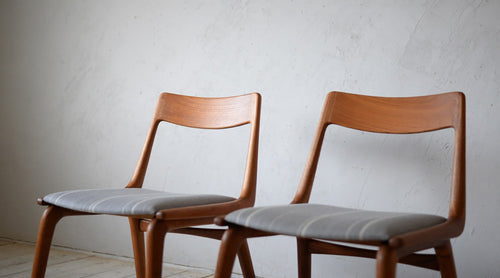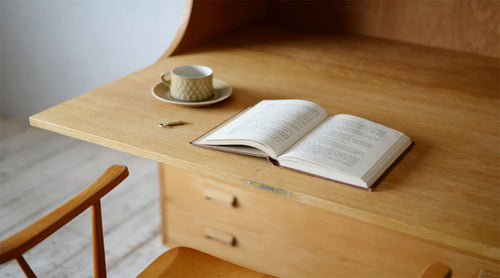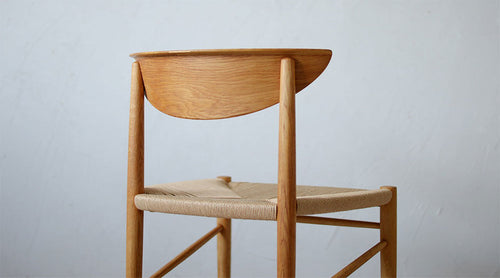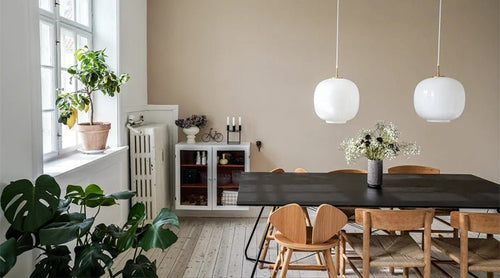- アイテム紹介
A classic that continues to this day: the modular bookcase
Have you heard of Mogens Koch?
In Denmark, he is one of the people who has received many honors, such as being a "famous designer, architect, professor...", but I have the impression that he is not very well known in Japan. And I'm sure that the majority of people who know him are fans of Denmark and furniture.
In any case, to be honest, if the general public doesn't know about him, it's hard to gain recognition in Japan. I hope that this article will help you learn about him and his wonderful works, even if it's just a small contribution.
One of his signature works: the modular bookcase

This is a bookcase designed by Koch for FDB Möbler . At first glance, it looks like an ordinary design, but it is surprising that it has been loved for over half a century since its release in 1944.
Why has it remained popular even today? There is, of course, a reason and a story worth telling. In this article, I would like to talk about this bookcase while briefly reviewing Koch's career.
What is Mogens Koch?

In a nutshell, he was a disciple of Kaare Klint, known as the "father of Danish modern design," and can be said to be "one of the people who laid the foundations for Denmark's Golden Age."
◆Biography
Born in Denmark in 1898
1925 Graduated from the Royal Danish Academy of Fine Arts, where Kaare Klint was professor.
In 1925, he worked at Kaare Klint's office, as well as at Carl Petersen's and Ivar Bentsens' offices (until 1932).
In 1934 he established his own firm.
1938 Eckersberg Medal
1944 Designed a bookcase for FDB Möbler
In 1950, he became professor of furniture at the Royal Academy of Arts (until 1968).
1963 CF Hansen Medal
1992: Received ID Prize and passed away
If we look more closely at his career, we can see that Koch joined the office of his head professor, Kaare Klint, in the same year that he graduated. This shows that Koch was greatly influenced by Klint and was also a talented person.
Even after he left the firm, he continued to work in a wide range of fields, including designing and writing about houses, extensions, furniture, textiles, graphics, and silver products, while still following the principles of functionalism that he learned from Klint. He must have been a very skillful person. In later years, he used his experience to teach for 18 years. He was a person who not only created but also mentored the next generation of designers and contributed to the Danish design industry.
Why have Koch bookcases been so popular for so many years?

1928: It all started as a study for himself
The origins of this bookcase can be traced back to 1928, when Koch designed it "for use in a small study in his own home." He adopted a modular system that was revolutionary at the time, and designed a bookcase that could be adjusted to fit the contents of its contents using a variety of parts such as doors, shelves and drawers. As it was made for his own use, it can be assumed that he sought to create a bookcase that was "ease of use" and "functional beauty" that would be suitable for real-life use.
1932: Sales begin at Rud Rasmussen

In 1932, four years after the design for his own home, the bookcase was sold by Rudo Rasmussen, a company known for its uncompromising furniture making and traditional craftsmanship. This bookcase attracted a lot of attention and popularity at the time.
However, even at the time, it was quite a luxury piece of furniture, and was not priced so that the average person could easily buy it. I have heard that for the Danish people, owning a Koch bookcase was a sign of success and something to aspire to.
Rudo Rasmussen was a long-established workshop that lasted for over 140 years, but unfortunately closed in 2016. Today, it continues to be loved and passed down by Carl Hansen & Son .
About RUD RASMUSSENS (1869-2016)
A long-established furniture workshop that was in business for over 140 years and is no longer in operation.
As the oldest in Denmark, it has led the way in Danish modern furniture with its uncompromising furniture making and traditional craftsmanship.
He also produced many pieces at the same workshop from 1944, and is known as the "father of modern Danish furniture."
The logo was designed by Kaare Klint and remained in use until the workshop closed.
In 2011, the workshop became part of Carl Hansen & Son, but sadly closed in 2016.
1944 Finally appeared in FDB Möbler!

Then, in 1944, towards the end of the Second World War, FDB Möbler finally released the Koch bookcase. It had been 12 years since the launch of the Ludo Rasmussen bookcase.
For the launch, Koch kept the basic design philosophy intact, but actively worked on the strict development conditions set by FDB Möbler : "durable, beautiful, functional, and affordable." They must have been able to keep the price down by limiting the variations and increasing production efficiency while maintaining the quality they had been aiming for.
In addition, the size has changed from the previous 760 x 760 mm waist-high square module to a small 540 x 360 mm with a beautiful aspect ratio. The bookcase released by FDB Möbler is said to have been popular with the younger generation at the time due to its light and simple design and the high degree of freedom that the modules offer.
Is it rare to find a bookcase made entirely from solid wood?

Both manufacturers say that all Koch bookcases are made from solid wood. This is unusual for "box furniture," which often uses a lot of plywood, but the reason is simple: when the design was first created in 1928, plywood technology was not common. (It was over 90 years ago...) Even today, the bookcases are still made from solid wood, which gives them a sense of luxury. It can also be said that the passage of time has added new value.
Furthermore, if you look closely at the FDB Möbler bookcase, you will see that the details are nicely rounded and the joints are made of knurled joints. This is not only good to look at, but is also a commitment to increasing strength. The "basic design" and "functionality that can be combined" are the foundations of the many box-type shelves available today, and may be the reason why they have not lost their modernity.
Various ways to use it depending on your ideas
Koch bookcases can be used in a wide variety of ways by stacking them together. You can stack boxes on the base to create freestanding storage, or you can attach them to the wall to use as a wall-mounted shelf. (There are screw holes on the back, so once you've decided on the position, you can simply screw them in.) They come in different depths, so choose the one that best suits your space and purpose.
Use as a stand-alone device 


If you use it as a freestanding case, it will be placed close to the floor, so it is recommended not only as a bookshelf but also as storage for children. Open-type storage makes it easy to take things out and put them away because you can see them. We have heard stories of children taking the initiative to tidy up after introducing the case. However, if you feel that "it's a bit too much to see everything...", it may be a good idea to use small baskets together.
By the way, the recommended load capacity for freestanding boxes is approximately 50kg (vertical orientation) and 60kg (horizontal orientation). If you have around two boxes, there is no problem placing them on the floor without attaching them to the wall. However, if you have three or more boxes, it is safer to secure them to the wall.
Use on a wall 


If you mount it on the wall, you can install it at any height you like. By installing it at eye level, you can use it as a decorative shelf to display your favorite items. Personally, I recommend shelves with a shallow depth as decorative shelves. They are easy to use because they do not cast too much shadow on the items you place on them and do not feel oppressive. If you line them up in a grid like in the image, it creates just the right amount of tension and tightens up the space.
The load capacity is approximately 30kg regardless of orientation. Since the wall alone supports the load, it is obvious that the weight it can withstand is less than if it were placed on the floor. The load capacity also varies depending on the structure of the wall, so be sure to check before installation. To ensure that the product can perform to its full potential, please use long screws.
The FDB Möbler showroom in the home country was packed with ideas
Finally, I would like to briefly introduce the FDB Möbler showroom that I visited last year. In addition to practical combinations of 2-3 bookcases, there were some hints on display and usage that are unique to the store.
A wall full of bookcases

In the FDB Möbler showroom, the entire wall is used for a bold display. Modular Koch bookcases are stacked, lined up, and arranged vertically and horizontally in a playful and unconventional arrangement. It is a powerful sight to behold.
Incorporating it like custom-made furniture

A Koch bookcase was used as a built-in piece for the cash register. It has a narrow box built into it, but is this a custom-made size? The notched joints visible from the side are beautiful. We don't usually handle custom-made sizes, but if you're building a new house or planning a renovation, it might be interesting to try incorporating one as a piece of built-in furniture.
What did you think?
As expected from a disciple of Kaare Klint, the "father of Danish modern design," his work exudes beauty through its ergonomics and functional beauty. I hope you will enjoy the profound depth of the pared-down design that is characteristic of Danish design.
Daikanyama store Shibuya

